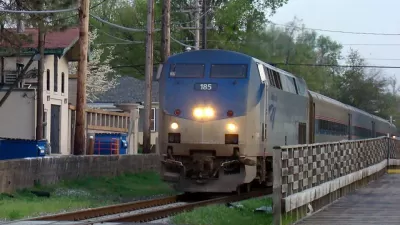The speedometer on the Chicago to St. Louis train hit 110 mph - and stayed there for five minutes, but it was enough to elevate the spirits of Transportation Secretary Ray LaHood and the other dignitaries on-board. Normal speeds top out at 79 mph.
The Associate Press' Jason Keyser reports on a symbolic Oct. 19 Amtrak ride that served as a morale-lifter for the Midwest's high speed rail advocates. The higher speed of 110 mph will become the norm for most of the route by 2015. This was the first time that Amtrak traveled that fast on any Midwestern route. Due to shared trackage with freight trains, it is not expected that speeds will go surpass 110 mph.
While the Northeast Corridor has its high-speed Acela train (see Eric Jaffe's Oct. 19 article on the 5% increase in Amtrak ridership in September over last year in this corridor that includes the Northeast Regional train in the Atlantic Cities) and California has it's embattled San Francisco-Los Angeles project designed to reach 220 mph, the Midwest has not received as much attention as high speed rail on the coasts. In fact, most publicity arose due to the rejection of the high speed rail grants included in President Obama's 2009 Recovery Act (stimulus funding) by Ohio Gov. John Kasich and Wisconsin Governor Scott Walker.
"Four years ago we were nowhere. Illinois and the country was a wasteland when it came to high speed rail," said U.S. Transportation Secretary Ray LaHood. "This is a dream come true today." Also on-board was Illinois Gov. Pat Quinn and other politicians and transportation officials and rail advocates, including Richard Harnish, director of the Midwest High Speed Rail Association.
"The improved Amtrak service in the Chicago-St. Louis corridor signals a genuine commitment to faster, safer, and cleaner travel", stated Harnish.
Not all in Illinois are advocates of the higher speed train service though. Kristina Rasmussen, vice president of the llinois Policy Institute, expressed doubts about the line's ability to break-even due in part to political pressure to keep fares low.
"We're yoking ourselves to trains that will obligate taxpayers to provide billions of dollars in future subsidies," she said.
FULL STORY: Illinois Amtrak Train Set To Hit 110 Mph In Test Run

Study: Maui’s Plan to Convert Vacation Rentals to Long-Term Housing Could Cause Nearly $1 Billion Economic Loss
The plan would reduce visitor accommodation by 25,% resulting in 1,900 jobs lost.

North Texas Transit Leaders Tout Benefits of TOD for Growing Region
At a summit focused on transit-oriented development, policymakers discussed how North Texas’ expanded light rail system can serve as a tool for economic growth.

Why Should We Subsidize Public Transportation?
Many public transit agencies face financial stress due to rising costs, declining fare revenue, and declining subsidies. Transit advocates must provide a strong business case for increasing public transit funding.

How to Make US Trains Faster
Changes to boarding platforms and a switch to electric trains could improve U.S. passenger rail service without the added cost of high-speed rail.

Columbia’s Revitalized ‘Loop’ Is a Hub for Local Entrepreneurs
A focus on small businesses is helping a commercial corridor in Columbia, Missouri thrive.

Invasive Insect Threatens Minnesota’s Ash Forests
The Emerald Ash Borer is a rapidly spreading invasive pest threatening Minnesota’s ash trees, and homeowners are encouraged to plant diverse replacement species, avoid moving ash firewood, and monitor for signs of infestation.
Urban Design for Planners 1: Software Tools
This six-course series explores essential urban design concepts using open source software and equips planners with the tools they need to participate fully in the urban design process.
Planning for Universal Design
Learn the tools for implementing Universal Design in planning regulations.
City of Santa Clarita
Ascent Environmental
Institute for Housing and Urban Development Studies (IHS)
City of Grandview
Harvard GSD Executive Education
Toledo-Lucas County Plan Commissions
Salt Lake City
NYU Wagner Graduate School of Public Service



























